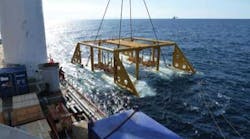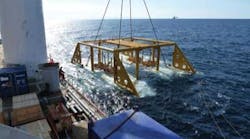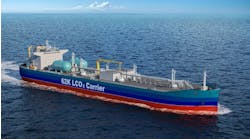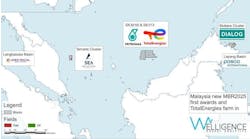Jeremy Beckman • London
The Norwegian Petroleum Directorate (NPD) has initiated two programs concerning future disposal of concrete production facilities offshore Norway. Only two structures in this category have been removed to date – Total’s Frigg TPC2 and ConocoPhillips’ Ekofisk storage tank – while the remaining 12 are still in operation. These include the Condeep concrete gravity base platforms, of which the oldest, Statfjord A, was installed in 1977, and the latest, Troll A, in 1995.
So far, no concrete facilities resting on the seabed have been transported from the field to land for dismantling, but NPD is mindful that the Oslo and Paris (OSPAR) Convention prohibits dumping of redundant facilities at sea. This summer, NPD plans to contract a study into the feasibility of transportation ashore and subsequent disposal. NPD is working also with Norway’s Climate and Pollution Agency (Klif) and Petroleum Safety Authority Norway to investigate cost and HSE issues associated with concrete removal operations.
Consultants Dr. techn. Olav Olsen, one of the inventors of Condeep, have issued a new report on disposal options. Technically, they say, removal from the seabed and re-floating are feasible, although this would entail comprehensive planning and risk management. In the worst case, an accident during the preparation phase, refloating, towing, or dismantling could lead to loss of life and environmental damage. And none of the installations are the same, so the challenges will vary.
One major issue will be mapping the platform’s condition, as several are over 30 years old and may have incurred unknown damage, impacting their stability. This could take the form of corrosion to reinforced steel structures, or strains imposed when the concrete substructures were mated to their decks. Another concern is the cement mortar placed under the platform during installation to equalize pressure and weight on the seabed. Cement parts could fall off during the raising procedure, affecting the platform’s stability.
Statoil tenders mature-field rigs
Statoil is inviting drilling contractors to tender for two new-concept rigs for use as workhorses on its mature fields offshore Norway. Most of the recent newbuild rigs delivered to the sector have been designed for deepwater operations, the company points out, making them too costly for routine fasttrack tiebacks to shallow water platforms in the North Sea.
The new Category D rigs will operate in water depths of up to 500 m (1,640 ft), and drill to subsurface depths of up to 8,500 m (27,887 ft), primarily for production purposes. The contract, which should be awarded this summer, will run either for eight years with options, or for a firm 20-year period. This should limit the risk to the selected contractor. Statoil hopes to take delivery of the rigs during the second half of 2014.
Development spending slows UK decline
Capital investment in projects across the UK continental shelf is on the rise, according to Oil & Gas UK’s latest activity survey. The report, based on the intentions of UK offshore operators, forecasts E&P spending this year of up to £8 billion ($12.89 billion), compared with just under £5 billion ($8 billion) in 2009. And if all new field developments on the drawing board go forward, annual expenditure could be sustained at this higher level for the next five years. That could slow the recent decline in UKCS production to around 3%/yr through 2016.
Much of the capex increase is due to the approval of large new development and redevelopment projects, particularly west of Shetland. Oil & Gas UK says 13 new projects were started last year, and there are potentially a further 67 developments with combined recoverable reserves of 3.1 Bbbl, with the 10 largest accounting for 60% of likely capex.
Last year UK fields delivered 850 MMbbl, or 2.3 MMboe/d. Current plans are targeting 11.6 Bboe of reserves, up 1.3 Bboe on last year’s survey forecast, reflecting drilling results during 2010 when 62 exploration and appraisal wells were spudded and completed. Oil & Gas UK anticipates a similar number this year.
On the downside, UK field operating costs continue to rise, and the industry anticipates decommissioning costs of £29 billion ($46.7 billion) over the next 30 years, up 11% on last year’s figure.
Trym flow starts
DONG Energy has turned on the taps at Trym, the first cross-border development project in the Norwegian/Danish sectors of the North Sea. This gas/condensate field is just north of the offshore median line between the countries. Development involves two horizontal wells connected to Maersk’s Harald platform on the Danish side. From there, the gas heads through a DONG-operated pipeline to Maersk’s Tyra platform for onward delivery to markets in Denmark and the Netherlands. Trym’s oil and condensate passes through another pipeline via the Gorm field to Fredericia in Denmark.
The Trym subsea manifold undergoing installation in the Norwegian North Sea.
ExxonMobil set for Faroes drilling debut
ExxonMobil has farmed into three licenses operated by Statoil offshore the Faroe Islands, which were awarded in 2000 and 2005. The duo plan to drill an exploratory well this summer, the first in this region since Eni’s unsuccessful wildcat last year on the Anne Marie prospect.
At the southern end of the Atlantic margin, a partnership led by Providence Resources has opted to enter the second phase of the FEL 2/04 license, 200 km (124 mi) off western Ireland in the Porcupine basin. Phase II includes a firm commitment to drill a well.
This license and FEL 4/08, held by the same partnership, include the Spanish Point gas/condensate and Burren oil discoveries. A competent persons report compiled by Senergy estimated respective resources in the two finds at 200 MMboe and 66 MMbbl, respectively.
Recently, Providence announced plans to raise over $65 million via a shares placement to help finance 10 wells it plans to drill in six basins through 2013.
Offshore Articles Archives
View Oil and Gas Articles on PennEnergy.com




